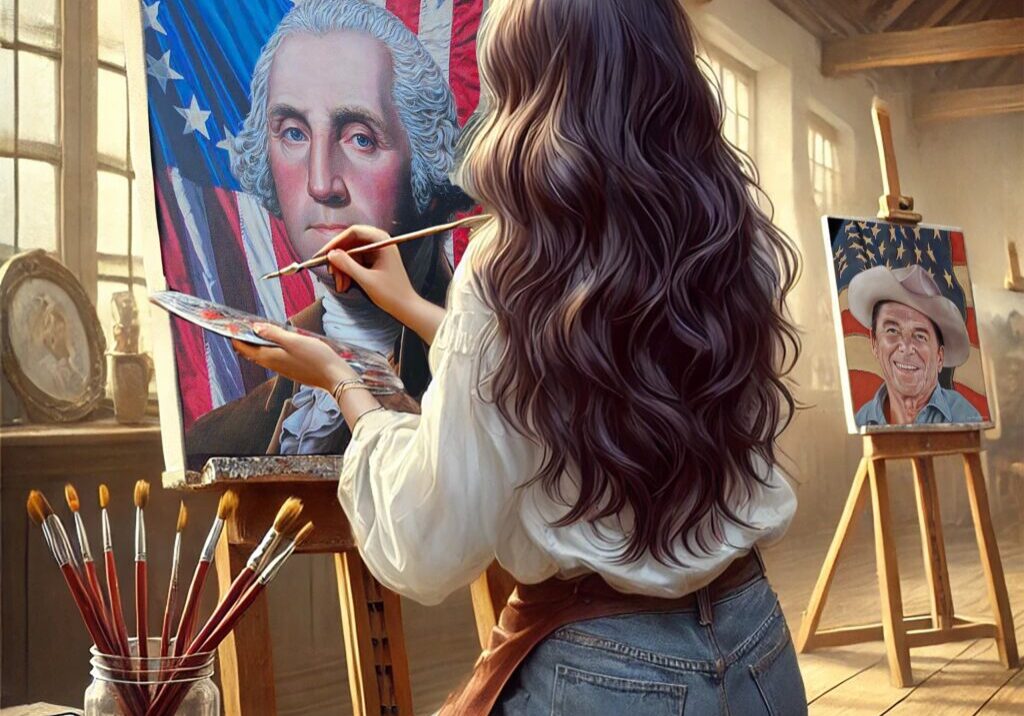
When the Paint Speaks: How Rosemary Vasquez Tuthill Brings Protest Imagery to Life
Some of the most powerful voices in the Revolution never spoke a word aloud. They were painted, printed, scrawled, and nailed to wood. Protest lived in ink and image – on handbills, banners, tavern signs, and broadsides. These weren’t meant to last, but they moved people. And for me, one of the most meaningful parts of creating the 250th Anniversary Mural has been finding a way to let those protest images live again – not as relics, but as something still speaking. I treat protest imagery as its own kind of character in the mural.
These are not background details. They’re visual declarations. A crumpled flier, a hastily brushed sign, or a partially torn broadside carries more than just information – it holds the temperature of the moment. When I paint these elements, I’m not just reproducing history. I’m translating the urgency that once pulsed through them. To bring that energy forward, I rely on expressive brushwork. Protest is rarely clean. It’s bold, fast, sometimes messy. That’s why I use dry brush techniques to roughen the edges of signs. I let pigment fade at the margins or drip just slightly where the ink would have run. These imperfections are part of the truth.
They make the visual language more alive, more emotional. If the paper looks too perfect, the meaning feels too distant. Placement also matters. A protest flier in the corner of a frame sends a different message than one held front and center. In some scenes, I tuck posters into shadow – so they’re discovered, not announced. In others, I let them fly free in the wind, unanchored but rising. This gives each piece its own narrative.
Every protest image has a life. It was printed, placed, seen, torn down, maybe passed from hand to hand. I want that movement to echo in the mural. Some protest images are symbolic rather than textual. I include recurring elements like broken crowns, open shackles, bleeding hearts, or coiled snakes. These weren’t invented for the mural. They were already part of Revolutionary visual culture. But I adapt them – changing their scale, embedding them within composition, letting them appear mid-story rather than as finished emblems. When I paint a broken chain, it’s not always hanging. Sometimes it’s being stepped over. Sometimes it’s being picked up.
Color plays a big role in how I express the heat of protest. Reds and blacks dominate many of these elements. Not bright crimson, but deep, burnished tones – colors that look like they’ve been through fire or soaked in ink. I contrast these with muted paper browns or bleached parchment whites, so the words or symbols stand out like sparks in ash. These choices are emotional, not decorative. Protest doesn’t whisper. It insists. Sometimes I include text, but I don’t always make it readable. That’s deliberate. Not every message needs to be legible to be felt.
A viewer might recognize the curve of a word or the weight of a phrase even if they can’t decipher the whole line. That ambiguity invites reflection. It lets the viewer imagine what might have been written there. It mirrors the way many of these documents were seen – partially obscured, read aloud in haste, remembered in fragments. What I love most about painting protest is that it allows me to honor the invisible.
The people who made these posters, carved these stamps, or painted signs under cover of night were often unnamed. Their art wasn’t framed or preserved. It was urgent. Temporary. Risky. And yet, it shaped a nation’s voice. In the mural, I try to give their efforts weight. I let them fly again – not to freeze them, but to let them move. When the paint speaks, it doesn’t just recreate the past. It reignites it. That’s what protest does. It reminds us that expression matters. That images can do more than decorate. They can demand. They can defy. And in the hands of artists – then and now – they can endure.

